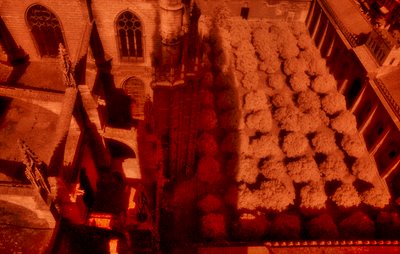
When I read a novel I never skip the Forewords the Prefaces or in the case of Robert Wilson’s The Ignorance of Blood, the Acknowledgments.
This is the last book in the Javier Falcón Seville Quartet and I would like to take the opportunity to thank the people of Seville for being so understanding at having all this fictional mayhem created in the streets of their beautiful and, comparatively, tranquil city…
My thanks to the brilliant Mr. Ravi Pillai and his assistant, Dr. Hassan Katash, whose surgical skills have kept the Robert Wilson show on the road...
I would perhaps be awfully pessimistic that Wilson’s last Javier Falcón novel (The Blind Man of Seville, The Silent and the Damned, The Hidden Assassins are the previous three) is somehow connected to Mr. Wilson’s health. I suspect that the case may be that he wants to write about other things. After all Wilson has written six other novels that have no connection with Seville and which I enjoyed tremendously. Perhaps Seville (or Sevilla as I prefer to think of it) has taken his Inspector Javier Falcón away from him much in the same way that Alec Guinness took George Smiley away from John Le Carré.
Sevilla can be that possessive. After all, the gold (and silver) of the new world in caravels and galleons went past San Lucar de Barrameda, at the mouth of the Guadalquivir River, a port that concocts its own pale gold, the bone dry manzanilla, and navigated the 80kms to the Puerto de las Indias in Seville. Madrid was just a town.
Spain squandered in Flanders all that gold and silver. But other treasures remained.
There were documents and maps that were housed in Archivo de Indias (The Archive of the Indies). My Manila born uncle, Don Luís Miranda often told me of his trip to Seville to this wonderful place that houses more than 53,000 documents and 8,000 maps and drawings. Accounts in the handwriting of Cortés, Pizarro, Balboa and Magallanes are there. I would suspect that the first maps that gave our new world its name, those drawn by Amerigo Vespucci must be there, too. The place conjures a marvelous world when Spain was its centre.
My first experience with Seville happened in 1985. Rosemary, Ale, Hilary and I stayed at the recently refurbished Alfonso XIII Hotel which was opened by that very king in 1929. Many of the European nobility stayed in the hotel in its glory days as did the best bullfighters that fought at la Plaza de Toros de la Real Maestranza de Caballería de Sevilla and the American author, Hemingway who was writing their story.
Perhaps it was because my daughters spoke English that the staff of the hotel thought we were Americans. They looked at us with stiff disdain and I could think their thoughts, “You Americans are defiling this great hotel that has seen so much Spanish history. Leave us your Dollars and go home.”
As much as I wanted to like Seville, I didn’t. I was tempted. At Santa María Cathedral I gazed on the tomb of Christopher Columbus. I was born in Buenos Aires and until I came to Vancouver October 12th was a holiday, el día de la raza or the day when a new race was born(the spin in those days was that the intermarriage between Spaniards and native Americans produced a superior race, even though mostly the whites, the Spaniards always seemed to be in charge.) Even the tomb was not all that satisfying. It seems the Admiral of the True Oceans’ body was divided a tad and part of his body is in the cathedral in Santo Domingo in the Dominican Republic.

Suffice to say, that Seville has never appealed to my mind but only a bit to my heart. In my heart is that black lace mantilla that my grandmother bought in Seville and always wore to cover her head when she went to Mass. It was with that mantilla that I photographed my oldest daughter Ale.

I fell in love with Seville because Javier Falcon's city, as written by Wilson, somehow became my own. As this Vancouver winter lingers into a cold spring I long for the hot days that Inspector Javier Falcón sweats in, loves in, eats, fights the bureaucracy of the Spanish judicial system and sometimes even drinks. Falcón mentions the heat but never complains.
It was at the bell tower of that Cathedral of Santa María, the Giralda that I also photographed Ale. You can see her at the bottom of the reddish picture. The other photograph is a the Patio de los Naranjos (Courtyard of the Orange Trees) adjacent to the cathedral and seen from the top of La Giralda which projected its shadow into the scene.
Perhaps soon I can return to Seville and see the city through the eyes of that melancholy man, Inspector Javier Falcón. His city would warm my heart.
Burriana, Seville Oranges & Dundee Orange Marmelade
Seville, Oranges, La Giralda, Spooks, Robert Wilson & A Sumo Wrestler






